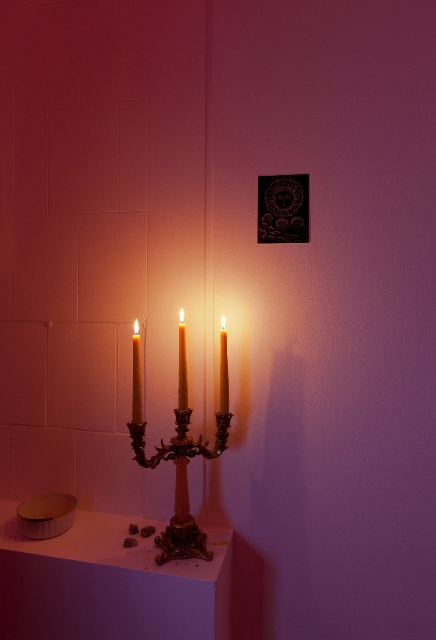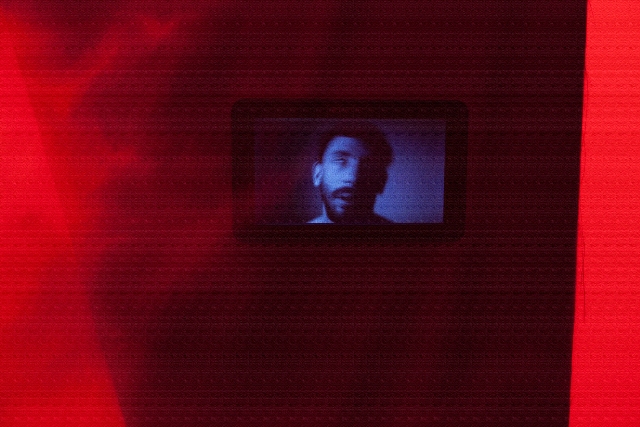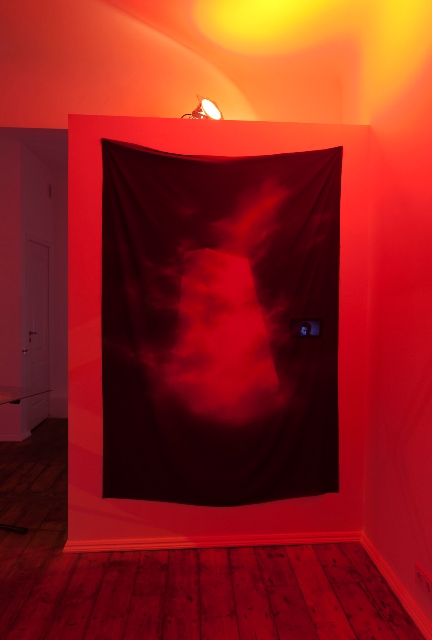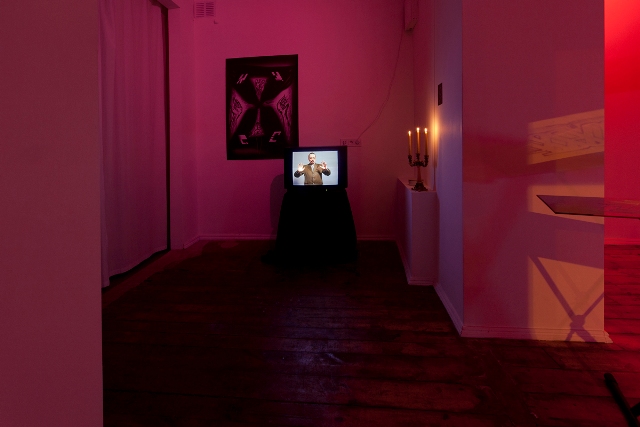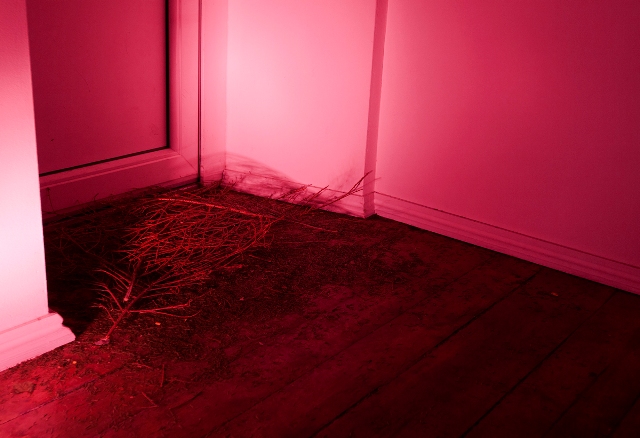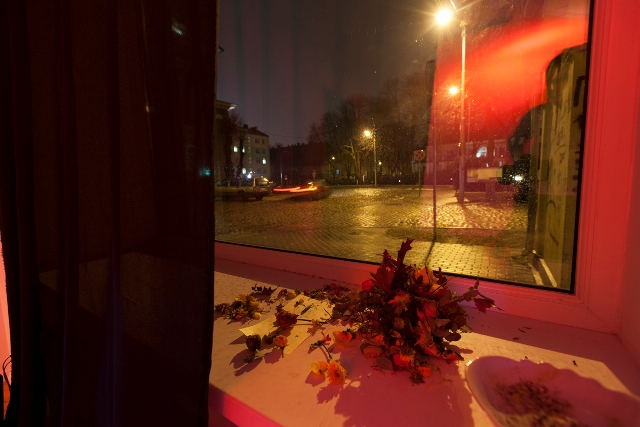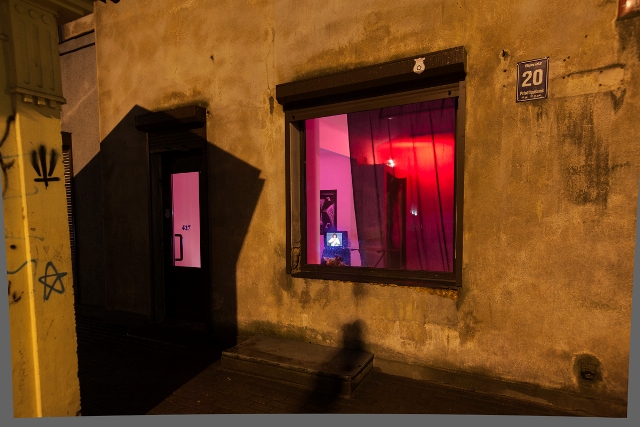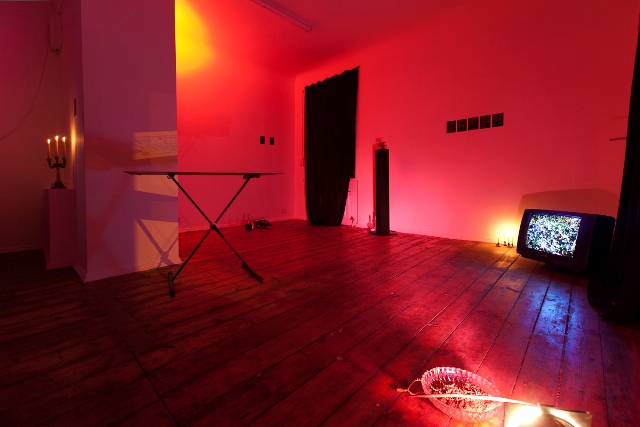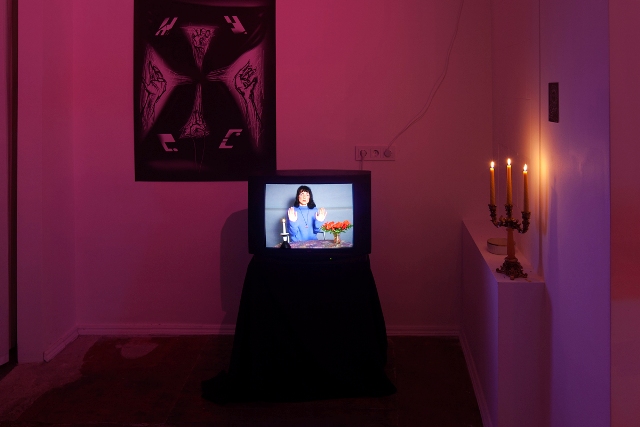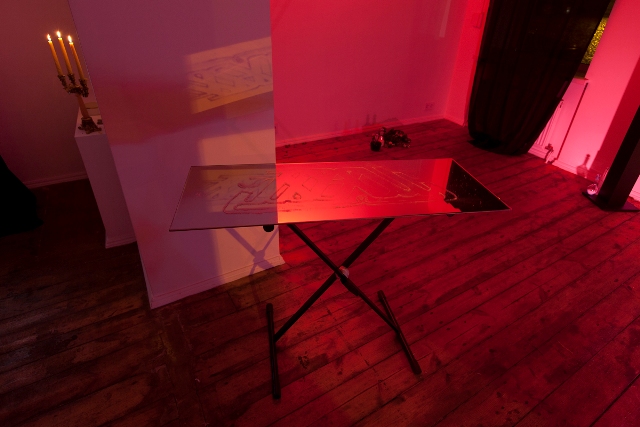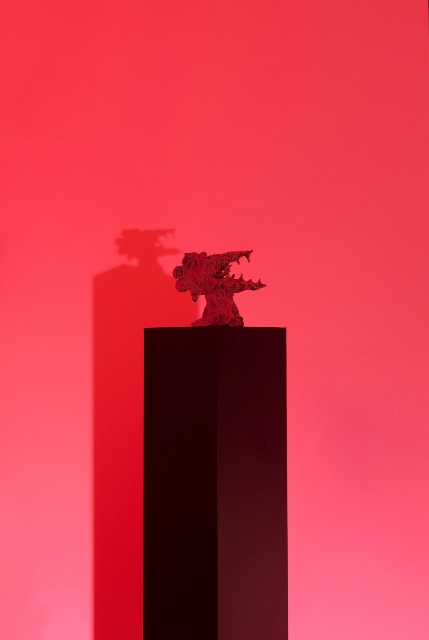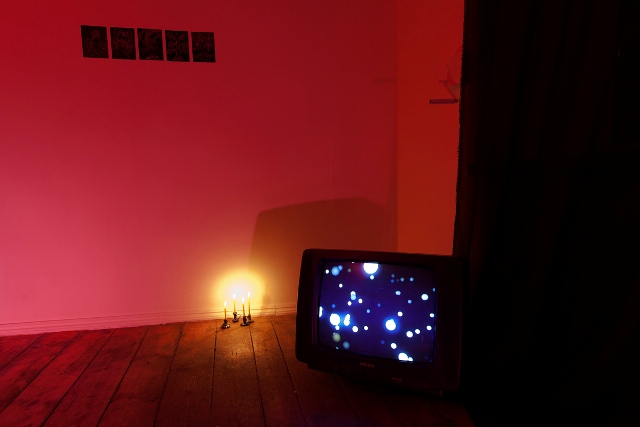Exhibition “A Guide to making a Genie” (Gallery “427”, 12.12.2014.–6.2.2015.)
Wizardry next to the Church of Jesus in Riga – the biggest wooden building in Latvia; on the Eve of New Year, gallery “427” hosted one of the conceptually most romantic exhibitions in Riga lately. Red lights, candlelight, dried flowers and tree needles, scattered amongst the exhibits, create a particularly cosy atmosphere in the darkest time of the year and make a person wish to linger on. And if the gallery premises stood on a chicken leg, I’m sure I would never summon my strengths to walk out of the witchy exposition, staying there till the very start of the spring. The favourable stenographic effects ensured a rapid entry into the exhibition’s esoteric spirit and stirred up thoughts of the link between art and magic – we all know that originally visual art was very closely linked to shamanic functions, and it seems that part of it still exist nowadays.
The title of the exhibition – “A Guide to making a Genie” – announces a motive which lies at the centre of the exhibition – notes by the so-called writer, poet and translator Mirdza Bendrupe (1910-1995) from 1930’s, in which she shares with an instruction to summon a “helpful spirit”. Mirdza Bendrupe tried to bewitch the unearthly powers to preserve the female beauty, but the “427” exhibition has turned into the process of summoning itself, using the power of seven artists instead of esoteric mantras. Referring to the notes by Bendrupe, it could be that this time the magic aims towards the beauty of art rather than that of body. However, this is not entirely true even though such a parallel of word games would seem witty; and it might be just because the content of the exhibition is to a great extent made by its dramaturgy.
No idea why exhibition curators Ieva Kraule and Kaspars Groševs used notes by Mirdza Bendrupe and no idea of the role of her personality for the exhibition idea. Interestingly, quite recently her witchy interests inspired one more cultural event – in April 2013 the Museum of Music and Literature, awaiting the Walpurgis Night, hosted a Mirdza Bendrupe esoteric lounge with a workshop “A Guide to making a Genie”. That could have been classified as a carnival-like, light entertainment, which thematically centred on an episode from the Latvian history of literature. The exhibition “A Guide to making a Genie” gives a similar visual impression; the works of art are truly integrated within the atmosphere of the room, making one wish to perceive those as one installation, in which every single work seems secondary in relation to the “whole”.
This is an approach which is not very typical of the so-called exhibition life in Riga, yet it vividly highlights a tendency characteristic of the “427” activity so far. Initially, the choice of artists and their artistic language, style and means of expression, as well as the conspiratorial, not very explanatory communication made gallery “427” remind just a bit too much of the post-conceptualist line of the contemporary art centre kim?, however with every next exhibition the gallery started showing more and more distinctions. The signature of “427” is characterised by irony and playfulness, a flirt with the indecisiveness of the contemporary art and its rights to self-determination. This distinguishes it significantly from its “big brother” kim?, which with the increase of its institutional significance more and more succumbs to the values demanded by the audience, the intensity of words and cultural policy. Theoretically this does not affect the level of the artistic quality, yet it inevitably makes the exhibition programme comply with the “national significance” and the task to reflect this or that aspect of the cultural life and notions of it. This time the principle of “quod licet Iovi, non licet bovi”((From Latin: What is permitted to Jupiter is not permitted to an ox.)) benefits “427”, allowing more freedom in action, creatively and experimentally within a similar conceptual setup.
Customary to contemporary art the exhibition “A Guide to making Genie” includes artists working with various media and themes, trying to view and deliver the exhibition theme in as many ways as possible, in order not to let the viewer become bored and to entertain it with variations of viewpoints. However the result is different from that of most such type group exhibitions. Usually, exhibition curators act as analysts of artworks, but in “427” the role of the curator and that of the artist merge to the highest degree – the exhibition has transformed from a mere display of works into an independent media, and the comment of the curators is the whole installation itself. In Latvia gallery exhibition curators habitually perform administrative rather than creative functions, hence the activity of “427” proves that there can be some other way and this “some other way” is very refreshing.
The exhibition works are formally united by ritual features, supernatural tokens, images, their combinations and situations – surely in fairly ironic or obscure forms, so as not to make the exhibition seem a display of a sectarian crafts group. Even though the exhibition is very united, it would still be difficult to write and contemplate on it without looking at every particular piece. The exhibition artists include authors working with quite various means of expression and covering diverse themes, and it is the “composition” of those that attracts the attention. Works by foreign artists – a bit less known to a wider public – Alexandra Zuckerman and Lev Kazachenko (previously participating at the “427” opening exhibition “Farewell”) successfully fit into the exposition, yet are a bit more difficult to be perceived in an exhibition context. The gallery’s consistent refusal to provide explanatory comments of the art works, superseding those with poetically associative literally flickers makes it difficult to perceive the works in a traditional way where those are seen as a particular – aesthetic, ideological or metamorphic – realisation of an intention. On the whole, the idea is not to be spurned, however when the “unknown” and the “known” is to be viewed on the same spot, the first one risks failing, because the mind tends to interpret the unknown on the basis of the same regularities, which characterize the works of the “known” authors.
To a certain extent all works represent the supernatural and one of the exhibition’s successes includes the diversity of the ways the artworks play upon that feeling: Ieva Rubeze’s video “Zāles” (Medications) shows healers, the modern witches and wizards, the documentation of whose doings allows looking into a physically nearby, yet parallel world. Viktors Timofejevs’ “Spēka baznīcā” (Power Church) uses an encrypted language typical for the artist, mapping recognizable tokens into a system similar to digital information structures. The artwork invites associations with the symbols of Freemasonry, which is furthermore intensified by the title as it includes a reference to a cult building. Together with Ieva Rubeze’s work it reminds us of the strange position (according to an average rational Western European understanding), which these ideological tendencies have nowadays, although they fit comfortably within the cultures of the Middle Ages and pre-Enlightenment and, regardless of the enormous differences of lifestyles, have succeeded to remain and keep existing even in the mutant forms of the 21st century.
The supernaturalness of the exhibition is best expressed by Atis Jākobsons’ video installation “Raz” – a dark cloth covers a video screen, through which a trance-overtaken man – possibly embodying a Genie or being the summoned Genie himself – addresses the viewers. The half transparent cloth gives a precise form to the mystery, which Jākobsons uses in his works to express the inner and the outer world, things, their essence and the place where it meets our consciousness. Jākobsons’ work sends out some irrational, subconscious-related fears, yet Raids Kalniņš’ mini sculpture “Sargātājs” (Protector) relates to the artist’s long-term wanderings within the horror aesthetics, in which the artist, using images of goblins and horror stories, approaches the romantic “other world”.
The young and promising video artist Zane Raudiņa offers the exhibition’s most witchy version of a Genie – dreamy hypnotic sceneries, filmed from crazy heights. The look at the romantic sceneries from another perspective disintegrates from time to time into cosmic ornaments. Compared to all moods of the supernaturalness, this natural mystery seems the most familiar to an average spectator, and Zane Raudiņa has managed to reveal it in a way which is able to unite the romantic and the monumental, without any banalities typical of the theme.
Due to their small size, Alexandra Zuckerman’s small goblin drawings, scattered across the gallery walls, have metamorphosed into a peculiar interior object “8 briesmoņi” (8 monsters) representing a type of mythology, which could be considered traditional, i.e., folk-like images and an interpretation of forms, naivety so typical of folk art; this is what brings a native and clean mythical thinking, so typical of witchcraft, into the exhibition. It’s complete opposite is the restrained installation by Lev Kazachenko, replacing romantic yearnings for the mythical with a design-like temperance.
The exhibition “A Guide to making Genie” doesn’t tell a lot, yet it piercingly gazes into the eyes of the viewer sort of trying to telepathically reveal something. This one-way communication is quite typical of previous “427” exhibitions, yet this time it exonerates itself by hiding behind the romanticism of the theme. The free format of “427” exhibitions is an essential advantage and a sign of peculiarity, however it also entails a dangerous potential of aimlessness, which is not rare with various temporary freedoms. Just some dragons, monsters and evil stepmothers need to be fought and then life will be happy ever after.
Relevant articles: In a Subway Tunnel with an Artificial Escort
